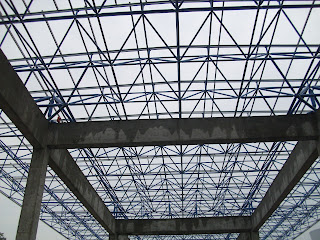Steel Structures in Airport Terminals — Creating Safe, Spacious, and Modern Air Hubs
Airport terminals are among the most complex buildings in the world. They require large, open spaces, heavy passenger traffic capacity, high safety standards, and the flexibility to adapt to future aviation demands. To meet these engineering and architectural challenges, steel structures have become the preferred solution in airport construction worldwide.
From long-span roofs to modern architectural forms, steel provides the ideal combination of strength, aesthetics, and efficiency, helping airports operate smoothly while maintaining an impressive visual identity.
1. Why Airport Terminals Need Steel Structures
Airports serve millions of travelers every year and must maintain strict performance requirements. Terminal buildings need:
-
Wide column-free spaces to accommodate crowds, luggage systems, and commercial areas
-
Large-span roofs that cover long check-in halls and departure lounges
-
Durability to withstand constant use and environmental exposure
-
Flexibility for future expansions and functional upgrades
-
Architectural impact, reflecting a city’s image and international presence
Steel structures make all of this possible thanks to their high strength-to-weight ratio, modular construction, and ability to support innovative designs.
2. Key Advantages of Using Steel in Airport Terminals
Long-Span Capability
Steel space structures and steel trusses allow airport roofs to span well over 100 meters without internal columns, enabling open, fluid passenger movement.
Enhanced Safety and Reliability
Steel performs well under seismic, wind, and vibration conditions — critical for large public facilities like airports.
Fast and Efficient Construction
Prefabricated steel components streamline on-site assembly, reducing construction timelines and minimizing disruptions.
Architectural Flexibility
Steel supports curved, wave-like, or free-form roof designs commonly seen in modern airports, creating iconic visual landmarks.
Low Maintenance and Long Service Life
With proper coatings, steel resists corrosion, fire, and weathering, lowering long-term operational costs.
3. Engineering Considerations for Airport Steel Structures
Designing airports requires advanced engineering coordination. Key considerations include:
-
Roof load management for large spans and complex shapes
-
Fireproof steel systems for passenger safety
-
Acoustic control in large interior spaces
-
Thermal performance using insulated cladding and skylight systems
-
Integration with MEP systems, including HVAC, lighting, and baggage-handling equipment
Modern tools such as BIM modeling and 3D structural analysis ensure accuracy and smooth collaboration among architects, engineers, and contractors.
4. The Future of Steel in Airport Construction
As air travel grows, airport terminals will continue to evolve. Trends include:
-
Sustainable steel solutions, using recyclable materials and green coatings
-
Lighter, more efficient roof forms enabled by updated steel design codes
-
Integration with solar panels, electric transport hubs, and smart facility systems
Steel’s adaptability ensures it will remain a core material for next-generation airport developments.
Conclusion
Steel structures enable airport terminals to be safe, spacious, durable, and visually impressive. They allow engineers and architects to balance functionality with design freedom while ensuring long-term performance. For modern aviation demands, steel remains the most reliable and future-ready building option.




评论
发表评论